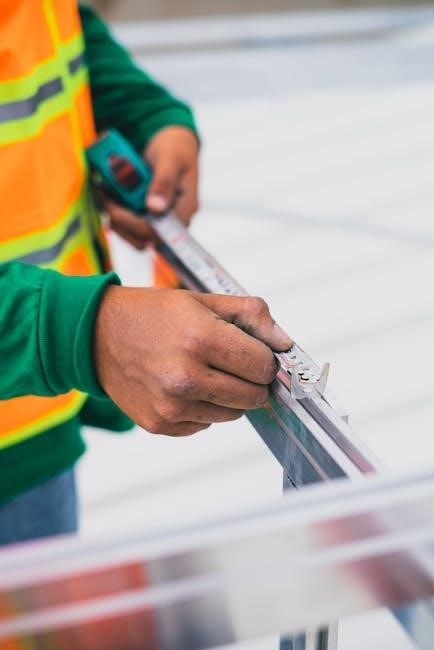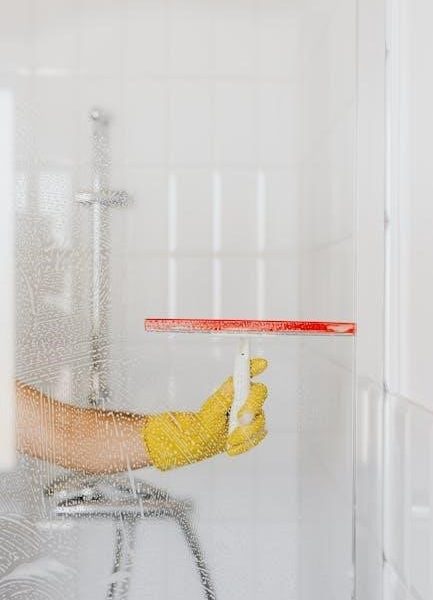A manual bar is a versatile tool used across various industries, from bartending to construction. It offers precision and efficiency, making it an essential asset in both creative and technical fields.
What is a Manual Bar?
A manual bar is a versatile tool or system used across various industries, offering precision and efficiency. In bartending, it refers to the physical counter where drinks are crafted, emphasizing creativity and technique. In construction, a manual bar often relates to rebar bending tools, essential for shaping steel reinforcements. In gaming, a manual bar can optimize performance through resizable BAR technology. Additionally, in user interfaces, it pertains to customizable taskbars or address bars, enhancing productivity. The manual bar’s design varies by application, but its core purpose remains consistent: to provide control, efficiency, and adaptability in different professional and technical contexts.
Types of Manual Bars

Manual bars come in various forms, each tailored to specific industries and applications. In bartending, a manual bar refers to the physical counter where mixologists craft drinks, emphasizing hands-on creativity. In construction, manual bars are tools like rebar benders, used to shape steel reinforcements. Gaming systems utilize manual bars as resizable BARs, enhancing performance. User interfaces feature manual bars like taskbars and address bars, aiding navigation. Each type serves unique purposes, from creativity in mixology to technical precision in construction and technology. Their designs vary, but they all prioritize efficiency, adaptability, and user control, making them indispensable in their respective fields.
Advantages of Using a Manual Bar
Manual bars offer numerous benefits across different applications. In bartending, they provide a personalized touch, allowing mixologists to craft unique cocktails with precision. In construction, manual rebar benders enhance efficiency and accuracy, reducing reliance on automated systems. For gamers, enabling manual bars like Resizable BAR can significantly boost performance, optimizing GPU utilization. In user interfaces, customizable manual bars streamline workflows, improving productivity. Additionally, manual bars often require less maintenance and are cost-effective compared to automated alternatives. Their versatility and adaptability make them a preferred choice in various industries, ensuring both functionality and creativity. Overall, manual bars empower users to achieve superior results through hands-on control and tailored solutions.
Bartender’s Manual Bar
A bartender’s manual bar is a comprehensive guide to mastering mixology, covering drink recipes, techniques, and essential tools. It serves as a one-stop resource for success behind the bar, ensuring consistency and creativity in every cocktail crafted.

Cocktail Recipes and Techniques
A well-crafted cocktail is both an art and a science, requiring precision and creativity. Essential tools like shakers, jiggers, and muddlers are indispensable for bartenders. Classic recipes such as the Old Fashioned, Margarita, and Mojito showcase fundamental techniques like muddling, shaking, and layering.
Mastering these methods ensures consistency and quality in every drink. Advanced techniques, such as infusions and molecular mixology, can elevate cocktails to new heights.
A bartender’s manual bar guide often includes step-by-step instructions, ingredient ratios, and tips for customization, making it a vital resource for both novices and professionals.
By combining traditional methods with modern innovations, bartenders can create unique and memorable experiences for their patrons.
Essential Tools for Bartending
A well-equipped manual bar requires a selection of essential tools to craft exceptional cocktails. A cocktail shaker is fundamental for mixing and chilling ingredients, while a jigger ensures precise measurements.
A muddler is crucial for crushing fruits, herbs, and spices to release flavors. Bar spoons, both long and short, are used for stirring and layering drinks.
Hawthorne and julep strainers help in straining ice and solids, ensuring smooth pours. A citrus juicer or press is vital for extracting fresh juices.
Bitters bottles allow for precise dashes, adding depth to cocktails. Garnish tools, like cutting boards and knives, are essential for preparing fruits and herbs.
An ice bucket with tongs keeps ice accessible and clean. These tools collectively enable bartenders to create diverse and high-quality beverages with ease and precision.
Professional Bartending Tips
Mastering the manual bar requires a blend of skill, creativity, and attention to detail. Always clean as you go to maintain a hygienic workspace and ensure efficiency.
Invest in fresh, high-quality ingredients, as they elevate the flavor and presentation of cocktails. Practice classic recipes to build a strong foundation before experimenting with innovative creations.
Engage with customers to understand their preferences, offering personalized recommendations. Keep your tools sharp and well-maintained to ensure precision in every pour and mix.
Stay organized by prepping garnishes, juices, and syrups in advance. Learn to multitask seamlessly, juggling multiple orders while maintaining focus.
Finally, never stop learning—explore new techniques, flavors, and trends to stay ahead in the bartending world. These tips will help you deliver exceptional experiences behind the bar.

Manual Rebar Bender
A manual rebar bender is a portable tool used in construction to bend steel reinforcement bars. It efficiently handles up to 6 (3/4, 20 mm) Grade 60 rebar, ensuring precise angles and durability with its lightweight, angled head design.
What is Rebar and Its Uses
Rebar, short for reinforcing bar, is a steel bar used to strengthen concrete structures. It is typically made from high-strength steel and features surface deformations for better bonding with concrete. Rebar is essential in construction, providing tensile strength to concrete, which is naturally weak under tension. Common applications include buildings, bridges, highways, and foundations. Available in various sizes and grades, rebar is selected based on the structural requirements of a project. Its primary function is to absorb stresses and prevent cracking, ensuring durability and longevity of structures. Proper placement and sizing of rebar are critical to achieve optimal results. Rebar is a fundamental component in modern construction, enabling the creation of robust and resilient buildings.
Manual Rebar Bending Process
The manual rebar bending process involves shaping steel bars to fit specific structural designs. Workers use handheld tools like manual benders or bending machines to achieve precise angles. First, the rebar is measured and marked according to blueprints. Then, it is placed in the bender, and force is applied to shape it. For smaller bars, manual bending is efficient, but larger diameters may require mechanical assistance. Safety is crucial, as improper bending can lead to material waste or structural weakness. Skilled laborers ensure each bend meets project specifications, making manual bending a cost-effective method for smaller-scale construction projects. This technique is widely used in onsite construction due to its flexibility and adaptability to unique design requirements.
Safety Tips for Manual Bending
Ensuring safety during manual bending is critical to prevent injuries and equipment damage; Always wear protective gear, including gloves and safety glasses, to protect against sharp edges and flying debris. Properly secure the rebar in the bending machine to maintain control and avoid accidents. Never overload the bender, as this can lead to mechanical failure. Keep loose clothing and long hair tied back to prevent entanglement. Regularly inspect tools for wear and tear, replacing them when necessary. Follow manufacturer guidelines for maximum bending capacity and angle limits. Proper training is essential; only authorized personnel should operate bending equipment. Additionally, ensure the workspace is clear of obstacles to allow smooth operation and minimize hazards. Adhering to these safety protocols ensures a secure and efficient bending process.

Manual Bar in Gaming
A manual bar in gaming refers to customizable controls or interfaces that enhance gameplay. Enabling features like ReBar can boost performance and optimize in-game experiences.
What is ReBar in Gaming?
ReBar, or Resizable BAR, is a feature in modern GPUs that allows CPUs to access the entire GPU memory, enhancing performance in gaming. It optimizes data transfer efficiency, leading to improved frame rates and reduced stuttering. AMD GPUs enable ReBar for all games, while NVIDIA uses a driver-based whitelist. This technology is part of AMD’s Smart Access Memory (SAM) and boosts performance significantly when enabled. Gamers can activate ReBar through BIOS settings or specialized tools like NVIDIA Profile Inspector. Proper implementation ensures smoother gameplay and better utilization of system resources, making it a valuable feature for gamers seeking optimal performance.

How to Enable Resizable BAR
To enable Resizable BAR, restart your PC and enter the BIOS/UEFI settings. Navigate to the advanced settings and look for the Resizable BAR option. Enable it and save changes. For NVIDIA GPUs, use NVIDIA Profile Inspector to select the game profile and enable Resizable BAR. For AMD GPUs, ensure Smart Access Memory (SAM) is enabled in Radeon Settings. Restart your system after making these changes. Some games may require a restart to utilize Resizable BAR effectively. Ensure your GPU supports this feature and consult your motherboard manual for specific instructions if needed.

Performance Benefits of ReBar
Enabling Resizable BAR (ReBar) significantly enhances gaming performance by allowing the GPU to access the entire video memory at once. This reduces latency and improves frame rates, especially in modern titles. For AMD GPUs, ReBar is enabled system-wide, offering consistent performance gains across various games. NVIDIA users benefit from a driver-side whitelist, ensuring compatibility and optimization. By enabling ReBar, gamers can experience smoother gameplay and faster load times. It is particularly beneficial for high-resolution textures and detailed graphics, making it a must-enable feature for optimal gaming performance. Ensure your hardware supports this feature for the best results.
Manual Bar in User Interface
A manual bar in UI enhances user experience through customization, allowing efficient navigation and task management. It streamlines workflows, boosting productivity with intuitive design and functionality.
Customizing Your Taskbar
Customizing your taskbar enhances productivity by streamlining access to frequently used apps and tools. Pin essential applications for quick launch and organize them logically. Rearrange icons to prioritize tasks, ensuring efficiency. Utilize the address bar for direct navigation, saving time. Personalize settings to display only necessary items, reducing clutter. Enable shortcuts for instant access to documents or folders. For touchscreens, optimize icon size and placement for ease of use. Regularly review and update your taskbar setup to reflect changing workflows. These adjustments ensure a tailored interface, boosting overall efficiency and user satisfaction. By fine-tuning your taskbar, you create a personalized workspace that aligns with your specific needs and preferences.

Using the Address Bar Effectively
The address bar is a powerful tool for efficient navigation and productivity. By typing URLs directly, users can quickly access websites without relying on bookmarks. Utilize search functionality by entering keywords, which often auto-suggest relevant results. Leverage the address bar for instant calculations by typing mathematical expressions. Additionally, it supports voice search for hands-free queries. Regularly clear browsing data to maintain privacy and optimize performance. Customize settings to enhance security, such as enabling safe browsing features. Explore keyboard shortcuts, like pressing Ctrl+L to focus on the address bar, streamlining workflow. By mastering these techniques, users can unlock the full potential of the address bar, enhancing their browsing experience and overall efficiency.
Productivity Tips with Manual Bars
Manual bars are indispensable tools for enhancing productivity across various tasks. Start by organizing your workspace to ensure easy access to the bar and related tools. Use keyboard shortcuts to streamline operations, such as quickly switching between tasks or accessing frequently used functions. Regularly maintain the bar to prevent wear and tear, ensuring optimal performance. Leverage built-in features like address bar shortcuts for efficient navigation. Prioritize tasks by focusing on high-impact activities first, then use the bar to automate or simplify repetitive processes. Stay updated with the latest techniques or updates to maximize efficiency. By integrating these strategies, users can significantly boost their productivity and achieve better results in their workflows.

Manual Bar in Automotive Repair
A manual bar is essential for diagnosing and repairing automotive issues, particularly in clutch systems. It helps maintain hydraulic systems and applies stop leak products effectively to prevent further damage.
Clutch Master Cylinder Maintenance
Clutch master cylinder maintenance is crucial for ensuring smooth gear transitions and preventing drivability issues. Regular inspections for leaks in the master cylinder, slave cylinder, and connections are essential. Using products like Bars Leaks Hydraulic Manual Clutch Fluid with Stop Leak can help recondition seals and prevent further damage. If leaks persist, replacing faulty components is necessary to maintain hydraulic pressure. Proper maintenance ensures consistent clutch performance, avoiding sudden failures. Always refer to the vehicle’s manual for specific guidelines and use high-quality products to guarantee reliability. Neglecting maintenance can lead to costly repairs and compromised vehicle safety.
Using Stop Leak Products
Stop leak products are designed to address leaks in hydraulic systems, particularly in clutch master cylinders and slave cylinders. These products recondition seals and gaskets, preventing fluid loss and maintaining hydraulic pressure. Bars Leaks Hydraulic Manual Clutch Fluid with Stop Leak is a popular solution, effective in reconditioning worn seals without disassembling the system. When applied, it helps stop leaks and ensures smooth clutch operation. Regular use can extend the life of clutch components and prevent costly repairs. For best results, apply stop leak products early to avoid major damage. Always follow the manufacturer’s instructions for application and dosage. If leaks persist, consult a professional for further inspection and repair.
Best Practices for Manual Repairs
When performing manual repairs, especially in automotive contexts, it’s crucial to follow best practices to ensure safety and effectiveness. Always use the correct tools for the job, as improper tools can damage components or lead to incomplete repairs. Cleanliness is key—ensure all surfaces and parts are free from dirt and debris before reassembly. Refer to the manufacturer’s manual for specific guidelines, as procedures can vary between models. After completing repairs, test the system thoroughly to confirm functionality. Regular maintenance can prevent future issues, so incorporate it into your routine. Documenting your process can also help track progress and identify potential improvements. By adhering to these practices, you ensure reliable and long-lasting repairs.

In conclusion, the manual bar is a multifaceted tool with applications spanning bartending, construction, gaming, and automotive repair. Its versatility and efficiency make it an indispensable asset in various industries. Whether crafting cocktails, bending rebar, optimizing gaming performance, or customizing user interfaces, the manual bar offers precision and control. By understanding its uses and best practices, users can maximize its potential. As technology evolves, the manual bar remains a reliable and essential tool, bridging tradition and innovation. Its enduring relevance underscores its importance in both professional and creative settings, ensuring it continues to be a cornerstone in many fields.


